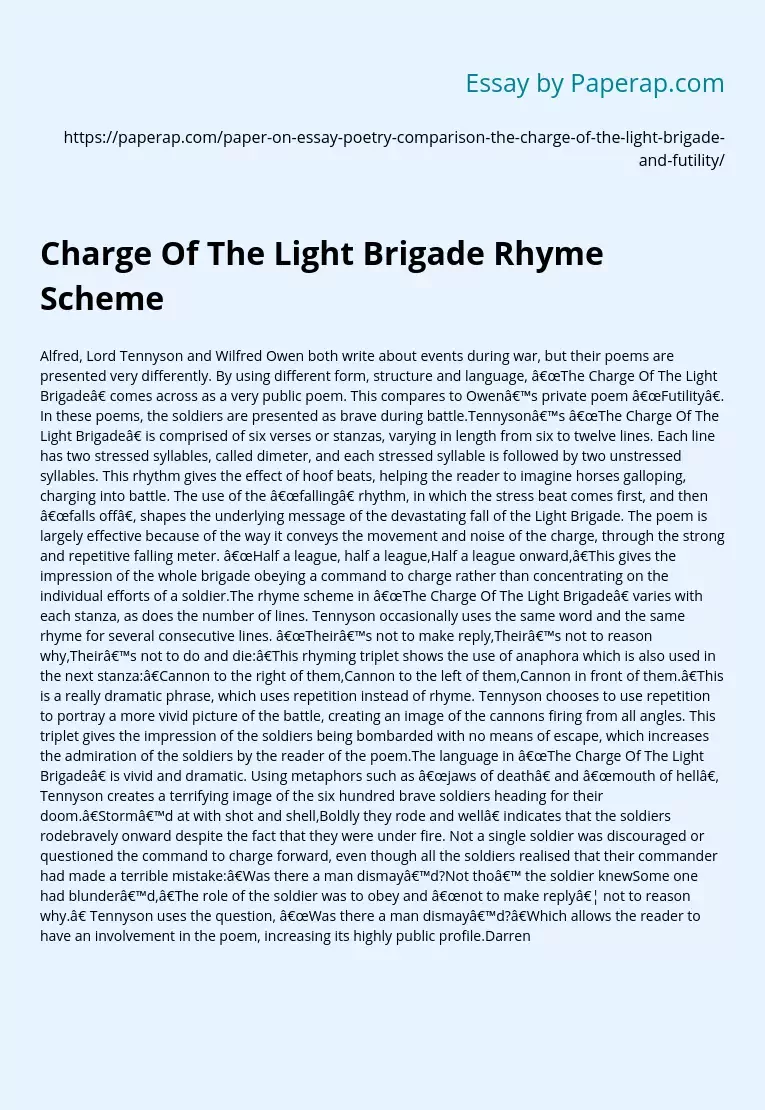Alfred, Lord Tennyson and Wilfred Owen both write about events during war, but their poems are presented very differently. By using different form, structure and language, “The Charge Of The Light Brigade” comes across as a very public poem. This compares to Owen’s private poem “Futility”. In these poems, the soldiers are presented as brave during battle.Tennyson’s “The Charge Of The Light Brigade” is comprised of six verses or stanzas, varying in length from six to twelve lines.
Each line has two stressed syllables, called dimeter, and each stressed syllable is followed by two unstressed syllables. This rhythm gives the effect of hoof beats, helping the reader to imagine horses galloping, charging into battle. The use of the “falling” rhythm, in which the stress beat comes first, and then “falls off”, shapes the underlying message of the devastating fall of the Light Brigade. The poem is largely effective because of the way it conveys the movement and noise of the charge, through the strong and repetitive falling meter.
“Half a league, half a league,Half a league onward,”This gives the impression of the whole brigade obeying a command to charge rather than concentrating on the individual efforts of a soldier.The rhyme scheme in “The Charge Of The Light Brigade” varies with each stanza, as does the number of lines. Tennyson occasionally uses the same word and the same rhyme for several consecutive lines. “Their’s not to make reply,Their’s not to reason why,Their’s not to do and die:”This rhyming triplet shows the use of anaphora which is also used in the next stanza:”Cannon to the right of them,Cannon to the left of them,Cannon in front of them.
”This is a really dramatic phrase, which uses repetition instead of rhyme. Tennyson chooses to use repetition to portray a more vivid picture of the battle, creating an image of the cannons firing from all angles. This triplet gives the impression of the soldiers being bombarded with no means of escape, which increases the admiration of the soldiers by the reader of the poem.The language in “The Charge Of The Light Brigade” is vivid and dramatic. Using metaphors such as “jaws of death” and “mouth of hell”, Tennyson creates a terrifying image of the six hundred brave soldiers heading for their doom.”Storm’d at with shot and shell,Boldly they rode and well” indicates that the soldiers rodebravely onward despite the fact that they were under fire. Not a single soldier was discouraged or questioned the command to charge forward, even though all the soldiers realised that their commander had made a terrible mistake:”Was there a man dismay’d?Not tho’ the soldier knewSome one had blunder’d,”The role of the soldier was to obey and “not to make reply… not to reason why.” Tennyson uses the question, “Was there a man dismay’d?”Which allows the reader to have an involvement in the poem, increasing its highly public profile.Darren Cave Page 1 5/2/2007″Futility” by Wilfred Owen is written in the form of a sonnet, in a battlefield in France. A sonnet is usually seen as a challenge to write; yet Owen seems able to write one, during a battle. The sonnet is split into two stanzas. The first stanza describes the situation in detail and the second invites the reader to get involved in making a comment. This is a very unusual way of writing a sonnet, as normally there is a rhyme scheme. In Shakespearean sonnets there is also a rhyming couplet in the last two lines. The sonnet has seven lines in each stanza and there is a clear change of thought pattern in the middle. It goes from the poet telling the story in the first stanza to him thinking things over in the second stanza.Owen uses the “eye” rhyme,”Until this morning and this snow.If anything might rouse him now”This looks as if it will rhyme, but it doesn’t, giving an incomplete feeling. There is also a stop after “snow”, which breaks the “eye” rhyme apart and “now” has no pause. The last three lines of each stanza are examples of half rhymes where the middle line is tied to the other two without the choppy effect that a pure rhyming triplet would have had.”Was it for this the clay grew tall?O what made fatuous sunbeams toilTo break earth’s sleep at all?”The second stanza has a link to the Bible. The Garden of Eden is referred to, bringing creation into a piece, which bases itself on the destruction and futility of war. In this stanza there are three rhetorical questions of which Owen is unsure of the answers. This creates a conversational effect and a more personal involvement in the poem. The language used, “home” and “its touch” is personal and private, emphasising the quiet, private feeling of events in war. I think that Owen captures this on a personal level as he wrote this poem as a soldier at the battlefront.These two poems are both structurally excellent and each one communicates its purpose well. Tennyson tells us of the bravery and togetherness of the soldiers. It celebrates the readiness of the soldiers as a unit to die for their cause-the emphasis is not on killing. Owen relates his feelings on the death of one individual soldier who fought bravely and died. Tennyson, who was a highly public poet, wrote this account ten years after the Battle of Balaclava as a memorial to it. The poem is written for presentation, in honour and glory of the “noble six hundred”. Owen is also successful in communicating, on a personal level, the death of a soldier, in the front line of battle. His poem gives more of a sense of loss then the honour, which Tennyson brings out in his poem.
Charge Of The Light Brigade Rhyme Scheme. (2019, Dec 05). Retrieved from https://paperap.com/paper-on-essay-poetry-comparison-the-charge-of-the-light-brigade-and-futility/

